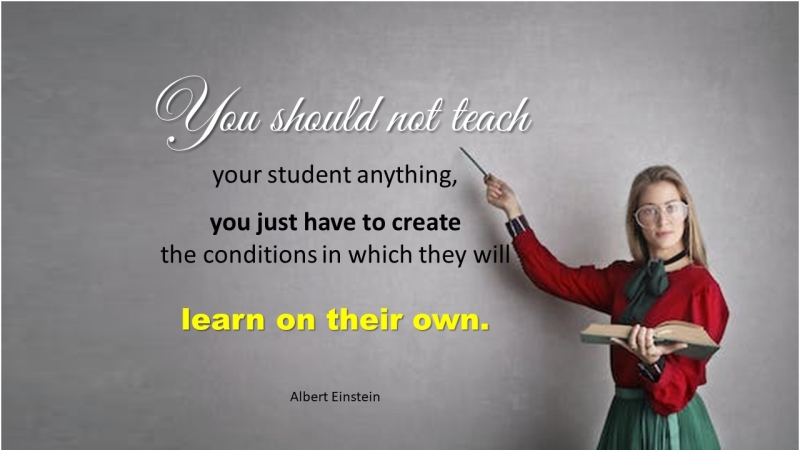ARE YOU TIRED OF THE TRADITIONAL TEACHING APPROACH THAT SEEMS TO FAIL SOME STUDENTS? Do you wish to unlock your students’ full potential and help them develop a love for learning? Then look no further! The solution lies in fostering a love of learning without teaching.
The traditional way of teaching is teacher-centered, which means that the teacher gives the students knowledge. However, this approach has drawbacks, as it only works for some students. Some students may find it challenging to learn in a classroom setting, while others may feel bored or uninterested. This is problematic because it undermines students’ motivation, performance, and outlook in the classroom.
The solution to this problem lies in fostering a love of learning without teaching. By doing so, students become more engaged and motivated and take ownership of their learning. They become curious, ask questions, and explore new ideas. This makes a good learning environment where students can do well and get excited about learning.
The Importance of Self-Directed Learning
Self-directed learning is the foundation for fostering a love of learning without teaching. It involves teaching students how to learn, not what to learn. By doing so, students become self-motivated, confident, and independent learners. They develop critical thinking skills, creativity, and problem-solving abilities. This way of teaching gets students ready to learn for the rest of their lives and gives them the freedom to pursue their interests and passions.
Creating a Positive Learning Environment
The first step to encouraging a love of learning without teaching is to make a good learning environment. Here are some tips for creating a positive learning environment:
Encouraging Curiosity and Exploration
Encouraging curiosity and exploration is essential to creating a positive learning environment. When students are curious, they become more engaged and motivated to learn. Here are some tips to encourage curiosity and exploration:
- Ask thought-provoking questions that encourage students to think deeply and critically
- Provide opportunities for students to explore and discover new things
- Encourage students to ask questions and be curious about the world around them
- Foster a sense of wonder and excitement about learning
Supporting Creativity and Critical Thinking
Another essential part of a good learning environment is encouraging creativity and critical thinking. When students are creative and think critically, they develop problem-solving skills and become more innovative. Here are some tips to support creativity and critical thinking:
- Provide opportunities for students to brainstorm and generate new ideas
- Encourage students to think outside the box and challenge assumptions
- Foster a culture of risk-taking and experimentation
- Provide opportunities for students to engage in creative activities, such as art, music, and drama
Providing Opportunities for Collaboration
Collaboration is essential for creating a positive learning environment. When students work together, they develop social skills and learn from each other. Here are some tips for creating opportunities for collaboration:
- Give students collaborative assignments to complete together.
- Encourage students to share ideas and give feedback to each other
- Provide opportunities for students to collaborate outside of class, such as through extracurricular activities or clubs
- Foster a culture of respect and cooperation
Celebrating Diversity and Individuality
Finally, celebrating diversity and individuality is crucial for creating a positive learning environment. When students feel valued and respected for who they are, they become more engaged and motivated to learn. Here are some tips for celebrating diversity and individuality:
- Create a welcoming environment that values diversity and inclusivity
- Encourage students to share their unique perspectives and experiences
- Foster a culture of empathy and understanding
- Celebrate cultural events and traditions
A good learning environment is essential to encouraging a love of learning without teaching. You can help students succeed and develop a love of learning by encouraging them to be curious and try new things, supporting their creativity and critical thinking, giving them chances to work together, and celebrating their differences and uniqueness. So go ahead and try it out, and watch your students’ love for learning grow!
Facilitate Self-Directed Learning
Even if you don’t have a formal education, a self-directed study can help you develop a love of learning. We only teach so much about what to learn and how to learn it. The result is an increase in students’ self-esteem, motivation, and capacity for independent study. The mind’s analytical, creative, and problem-solving skills get more vigorous. This strategy is helpful because it encourages students to pursue their interests and prepares them to learn for the rest of their lives.
Let’s talk about how to encourage student autonomy in the classroom now and help them become lifelong learners. Here are the ways to do it:
Teaching Students How to Learn, Not What to Learn
Teaching students how to learn, rather than what to learn, is an important step you can take toward fostering a love of learning. When students know how to learn well, they are more self-motivated and more likely to keep learning independently. Some suggestions for instructing students in the art of learning:
- Teach study skills, such as note-taking, time management, and test-taking strategies
- Encourage students to set learning goals and track their progress
- Help students develop metacognitive skills, such as self-monitoring, self-evaluation, and self-regulation
- Model lifelong learning by sharing your own learning experiences and strategies
Fostering a Growth Mindset
Fostering a growth mindset in your students is another way to help them learn independently. When students believe they can learn and grow, they become more resilient and motivated to overcome challenges. The following are some suggestions for encouraging a growth mindset:
- Encourage a “yet” mentality, where students view challenges as opportunities to grow
- Praise effort and progress, not just achievement
- Provide constructive feedback that focuses on growth and improvement
- Help students develop a positive self-image and belief in their own abilities
Providing Resources for Independent Study
To facilitate self-directed learning, you’ll also need to provide resources for independent study. This might include access to books, online resources, or educational apps. Here are some tips for providing resources for independent study:
- Curate a library of books and resources that align with students’ interests and learning goals.
- Encourage students to use online resources, such as Khan Academy or Coursera, to supplement their learning.
- Give students a chance to develop their interests through activities such as individual projects and research.
Encouraging Self-Reflection and Self-Evaluation
Finally, encouraging self-reflection and self-evaluation is essential for facilitating self-directed learning. When students reflect on their learning and evaluate their progress, they become more self-aware and motivated to continue learning. Here are some tips for encouraging self-reflection and self-evaluation:
- Encourage students to think critically about their education by giving them journaling and discussion prompts.
- Encourage students to evaluate their own progress and set new learning goals.
- Help students develop a growth mindset by reframing failures as opportunities for learning and growth.
- Provide constructive feedback that encourages students to reflect on their learning and identify improvement areas.
Facilitating self-directed learning is essential for fostering a love of learning without teaching. You can help your students become lifelong learners motivated to keep learning by teaching them how to learn, encouraging a growth mindset, giving them resources for independent study, and getting them to think about and evaluate themselves. So go ahead and try it out, and watch your students’ love for learning soar!
Encourage a Love of Learning
Encouraging a love of learning is one of the most important aspects of fostering self-directed learning. When students are interested in learning, they are more likely to take the initiative and learn independently. Here are some tips for encouraging a love of learning:
Focus on Intrinsic Motivation
Fostering intrinsic motivation: intrinsic motivation is the desire to do something for its own sake instead of for rewards from the outside world. When students are self-motivated, they are more likely to enjoy learning and look for information on their own.
- Emphasize the joy of learning for its own sake rather than just getting good grades or pleasing authority figures.
- Encourage students to set their own learning goals and pursue topics that fascinate them. Create a sense of purpose by tying learning to students’ interests, goals, and values.
Provide Opportunities for Choice and Autonomy
When students have a say in what and how they learn, they are more likely to be engaged and invested in the process. To provide opportunities for choice and autonomy:
- Offer a variety of learning activities and projects that allow for different learning styles and preferences.
- Allowing students to select their areas of study, research questions, and methods of investigation will invite them to play an instrumental part in their education.
- Give students the freedom to work independently and take breaks as needed.
Recognize and Celebrate Progress and Achievement
To recognize and celebrate progress and achievement:
- Provide regular feedback focusing on the learning process rather than just the outcome.
- Celebrate small successes and milestones along the way rather than just focusing on the final product.
- Create a positive learning community that values collaboration and peer support. When students feel their efforts are valued and appreciated, they are more likely to continue learning and growing.
Use Positive Reinforcement and Feedback
To use positive reinforcement and feedback: positive reinforcement can be a powerful motivator for students.
- Acknowledge and praise students for their hard work, progress, and achievements.
- Provide specific and constructive feedback that helps students identify areas for growth and improvement.
- Encourage students to give each other positive feedback and support.
When you encourage a love of learning, you empower students to take charge of their education and pursue knowledge for the sheer joy of it. You can help your students become lifelong learners excited to learn more about the world around them by focusing on their motivation, giving them choices and freedom, recognizing and celebrating their progress, and using positive reinforcement and feedback.
Conclusion
By now, you should understand why traditional teaching methods only work for some students and how a self-directed approach can be much more effective in helping students achieve their full potential.
To recap, the key points we covered were:
- The importance of self-directed learning
- Creating a positive learning environment that fosters curiosity, creativity, critical thinking, and collaboration and celebrates diversity
- Facilitating self-directed learning by teaching students how to learn, fostering a growth mindset, providing resources for independent study, and encouraging self-reflection and evaluation
- Encouraging a love of learning through intrinsic motivation, providing opportunities for choice and autonomy, recognizing and celebrating progress and achievement, and using positive reinforcement and feedback
Fostering a love of learning can profoundly impact students’ lives. It can help them have a growth mindset, become more self-motivated, and, in the end, do very well in school and life. By creating an environment that supports self-directed learning, you can help your students discover their passions and acquire the knowledge and abilities necessary for fulfillment in any endeavor.
Even parents are educators since they are their children’s first teachers. So, the principles laid down in this article will be helpful to them.
So, as an educator, what can you do to foster a love of learning without teaching? It’s simple: Start by adopting a self-directed approach to learning. Encourage your students to take charge of their learning, give them the tools and help they need to do well, and celebrate their progress and accomplishments. By doing so, you can help them become lifelong learners, motivated to continue growing and achieving their goals.
Parents are educators, too, since they are their children’s first teachers. So, the principles laid down in this article apply to them. Let’s start fostering a love of learning today!
CLICK THE IMAGE TO LEARN MORE




